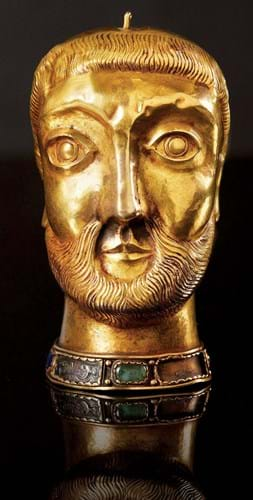
It was formerly owned by industrialist and medieval art collector Julien Chappée (1862-1957), from whom the Musée du Louvre and several other institutions acquired major works.
After his death, it entered the collection of numismatist Claude Vaudecrane and was then acquired by the vendor’s father in 1972.
Offered with an estimate of €70,000-100,000 at the June 22 auction, it was knocked down at €98,000 (£86,000) – €124,210 with premium.
The reliquary head dates from the latter half of the 12th century and was made in the southern area of present-day Belgium and the Rhineland.
These pieces of Rheno-Mosan art date from a time when the valleys of the Meuse and Rhine rivers became a pre-eminent centre for the production of reliquaries and liturgical art, in part reflecting the rise of pilgrimage in the Middle Ages. Items from this region were noted for their fine Romanesque style.
However, while silver or plated metal examples exist in greater number, fewer gold treasures were produced due to the expense, and fewer items have survived looting, fires, melting and iconoclasm over the centuries.
The 4½in (11cm) high tonsured head is made up of two embossed thick gold shells welded together vertically near the ears, and worked with a finishing tool for the hair, beard, pupils and the mouth.
A gold-tone band at the base with coloured glass and niello silver plate was a key element in identifying this work.
The tiny vine tendrils in the sole remaining silver plaque are similar to recurring patterns in precious Rheno-Mosan metalworks and very close to one of the hallmarks used by Nicolas de Verdun’s workshop in Cologne from 1181-1215.
£1 = €1.14














